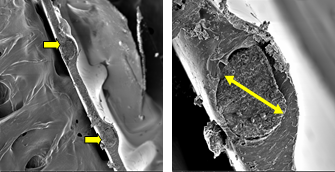Bioresorbable Device for Neural Injury Repair
Background
Nerve injuries are among the most difficult injuries to heal because under normal physiological conditions, mature neurons do not undergo cell division. The current standard of care for surgical intervention in nerve injuries is the tissue graft. However, this procedure can present several drawbacks including additional surgery, size mismatch, possible nerve damage at the graft site, and the formation of painful nerve tumors. Alternatively, several nerve guidance conduit or channel (NGC) devices have been approved for clinical use by the FDA, but to date the majority of these devices have not been able to match the functional recovery of traditional nerve grafting procedures.
Brief Description
Prof. Huinan Liu and her colleagues at the University of California, Riverside have developed a method for incorporating magnesium (Mg) microwires into nerve guidance conduits (NGCs) to improve neural healing. Mg-based microwires are naturally biodegradable and bioresorbable in the body, mechanically strong, and electrically conductive for neural stimulation and controlled release of neuroprotective ions. This bioresorbable neural device does not require removal surgery as it degrades in a natural and safe manner. Overall, the integration of Mg-based microwires into NGCs can accelerate nerve recovery process while eliminating the need for removal surgery.

Fig. 1: Scanning electron micrographs of Mg wire embedded in a polymer nerve guidance conduit (NGC). Cross-section.
Suggested uses
- Improved nerve guidance device for repairing nerve damage without requiring additional surgery for device removal
- Electrically conductive for stimulating neural healing
- Controlled delivery of neuroprotective Mg ions to reduce functional damage
Patent Status
| Country | Type | Number | Dated | Case |
| United States Of America | Issued Patent | 9,925,695 | 03/27/2018 | 2013-514 |
Contact
- Grace Yee
- grace.yee@ucr.edu
- tel: View Phone Number.
Other Information
Keywords
magnesium wire, poly(lactic-co-glycolic) acid, neural healing, PLGA, nerve guidance conduit channel, nerve guidance, bioresorbable
